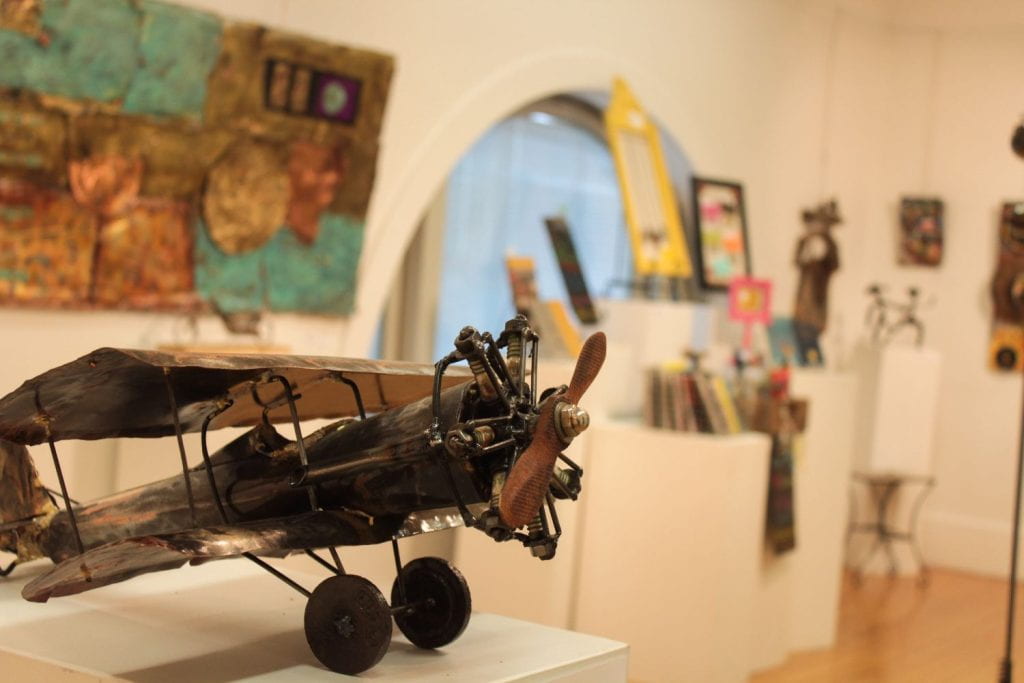By: Adam Falluji – Staff Writer
It’s often said that one man’s trash is another man’s treasure. With its new exhibit, Rethink Recycling, Danville’s Community Arts Center seeks to show that nothing is truly trash and that objects considered entirely useless can be reinvented into something unexpected with the right vision.
We live in a beautiful world, but in our means of producing things for our day-to-day lives we create a lot of trash and clutter. This waste is threatening our planet, and initiatives are growing daily to expedite recycling efforts and limit our wastefulness. Recycling doesn’t just mean sending paper, glass, and plastic to the recycling plants, however. The Rethink Recycling exhibit is one example of the numerous projects that use recyclable materials to create a new product.
With the intention of teaching that something can be produced from any medium, the exhibit shows that art is limitless.
“Art supplies don’t have to be expensive,” Brandon Long, Programming Director of the Community Arts Center, said. “You can make absolutely wonderful art using stuff that most people would just throw away… I find that found materials can often tell the story of a piece of art in ways that conventional materials might not.”

Long is also the artist behind many of the featured works and laid out the groundwork for the exhibit, planning it with a drawing of the desired scene rather than a technical 3-D map.
The exhibit’s ground floor is an elaborate nature scene, featuring flowers, butterflies, and numerous forest-dwelling animals, including a large cardboard bear produced by the Community Art Center’s artist-in-residence, Mark Wilhelm.
“When I found out there was going to be a recycling show, I was thinking about what method to use,” Wilhelm said. “I tried two or three different ones like chicken wire, but nothing was as environmentally friendly as cardboard, and it turned out the best.”
Working on the exhibit has also caused Wilhelm to think differently about recycling. “I never really cared about the environment before, but this definitely made me more conscious just because it showed me how all this was nothing and now it’s something,” he said. “It was cool seeing big piles of stuff turn into plants and animals. My friend came up with a name for it – ‘taxagomy,’ coming from taxidermy and origami.”
The bear took roughly 40 hours to complete with the assistance of the center’s interns. Overall, the exhibit took a week to install after being in the works for months. Behind rolling hills of paper-mâché is a cave tunnel with LED lighting and a projector screen displaying a looped clip of psychedelic bubbles. The interior of the tunnel is lined with wrapping paper, a particularly common waste produced by our society, put to use with artistic license.
A short walk upstairs brings viewers to art pieces made from old trash, reminiscent of Dean from The Iron Giant, created by local artists from here to Georgetown.
One room that’s an especially big hit for the numerous field trips from local schools features a variety of musical instruments made from recycled materials. Wind instruments are made from PVC pipes; a xylophone is made from old electrical conduits, while other percussive instruments are made from anything from glass bottles to cardboard. Mock violins, a guitar made from Chevy hub caps, and a broomstick are also on display, inspired by the Landfill Harmonic group that made instruments out of rubbish in a landfill in Paraguay. All of them sound surprisingly good.
Currently, members of Alpha Phi Omega (APO), a service fraternity on Centre’s campus, are taking the opportunity to get involved with the Community Arts Center and its exhibits.
“APO is a very community based organization, and we try very hard to reach all aspects of the Danville community. Volunteering at the Arts Center is a great way to do so, being that it serves the community as well,” first-year and APO member Paige Anderson said. “The main reason that I’m working with the Arts Center is the fact that I want a career in art history and to work in museums, and I love volunteering. I find service a fundamental part of personal development, and I saw this volunteer opportunity as a great way to combine my intended future and my love of volunteering.”
A tour of the exhibit is $4 for children and $6 for adults, and yet Centre students can get in for only $3. With so much offered so close to campus, a trip to the Community Arts Center is well worth the visit for students who want to rethink recycling, and reimagine art.
